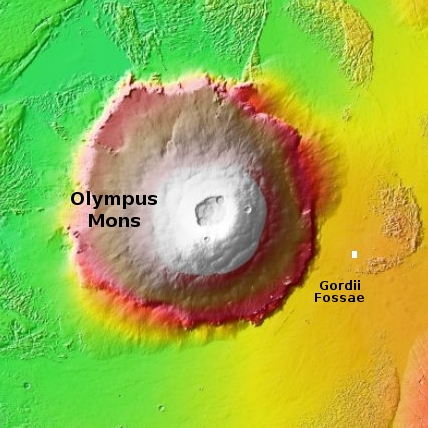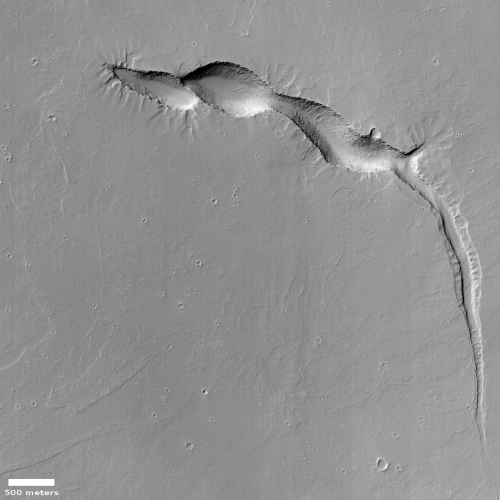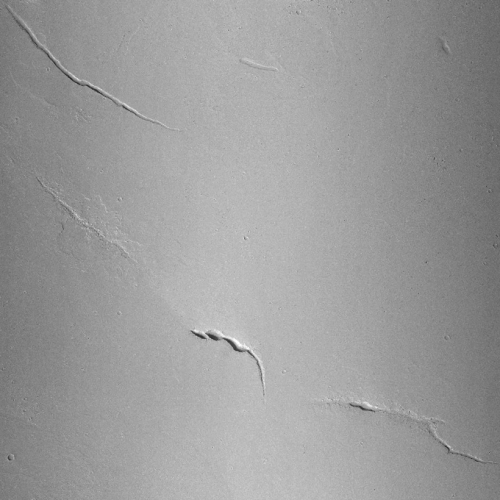A gecko on Mars
Today’s cool image is also today’s picture of the day from the science team of the high resolution camera on Mars Reconnaissance Orbiter (MRO. That picture, rotated, cropped, and reduced to post here, can be seen to the right. As the caption authors Sharon Wilson and Sarah Sutton write:
The smooth volcanic surfaces in the Gordii Fossae region are sometimes interrupted by long, narrow troughs, or fissures. These fissures form when underground faults, possibly involving magma movement, reach the near-surface, allowing material to collapse into pits or an elongated trough. This fissure appears to have erupted material that flowed onto the surface.
If you use your imagination, this trough resembles a gecko with its long tail and web-shaped feet!
This impression is even more evident in the wider image taken by MRO’s context camera below.

To my eye, the gecko is about to swallow a very big bug. It also appears to me to be followed by second, third, and maybe a third gecko, less visible because they are partly hidden by mist.
I know, I know, I am letting my imagination run away with me. What the wider image actually illustrates quite clearly are the underground fissures in this region, all aligned in a northwest to a southeast direction.
The overview map below helps even more to explain why these fissures exist. When Mount Olympus was growing, it imposed two major changes on this landscape. First the upward pressure of the volcano’s magma caused radiating cracks to occur in the surrounding terrain. Second, the volcano flooded that surrounding terrain with lava, producing the smooth lava flood plains. Because those lava flood plains are relatively young, they have few craters.
The result is a very smooth surface periodically interspersed with long narrow sinks. That one of those sinks now can be imagined by Earthlings as resembling a gecko is mere happenstance.
The overview map also underlines the difference between lava flows on Earth and on Mars. The distance from the caldera’s eastern rim and this fissure is about 140 miles. While much of the lava here probably came from much closer vents, the ability of Martian lava to flow faster and farther means that the volcano was able to inundate a much larger area than is possible on Earth.
When human geologists finally get to Olympus Mons I suspect they are going to end up mapping out a volcanic history that is truly monumental, far exceeding anything they can presently imagine.
On Christmas Eve 1968 three Americans became the first humans to visit another world. What they did to celebrate was unexpected and profound, and will be remembered throughout all human history. Genesis: the Story of Apollo 8, Robert Zimmerman's classic history of humanity's first journey to another world, tells that story, and it is now available as both an ebook and an audiobook, both with a foreword by Valerie Anders and a new introduction by Robert Zimmerman.
The print edition can be purchased at Amazon or from any other book seller. If you want an autographed copy the price is $60 for the hardback and $45 for the paperback, plus $8 shipping for each. Go here for purchasing details. The ebook is available everywhere for $5.99 (before discount) at amazon, or direct from my ebook publisher, ebookit. If you buy it from ebookit you don't support the big tech companies and the author gets a bigger cut much sooner.
The audiobook is also available at all these vendors, and is also free with a 30-day trial membership to Audible.
"Not simply about one mission, [Genesis] is also the history of America's quest for the moon... Zimmerman has done a masterful job of tying disparate events together into a solid account of one of America's greatest human triumphs."--San Antonio Express-News
Today’s cool image is also today’s picture of the day from the science team of the high resolution camera on Mars Reconnaissance Orbiter (MRO. That picture, rotated, cropped, and reduced to post here, can be seen to the right. As the caption authors Sharon Wilson and Sarah Sutton write:
The smooth volcanic surfaces in the Gordii Fossae region are sometimes interrupted by long, narrow troughs, or fissures. These fissures form when underground faults, possibly involving magma movement, reach the near-surface, allowing material to collapse into pits or an elongated trough. This fissure appears to have erupted material that flowed onto the surface.
If you use your imagination, this trough resembles a gecko with its long tail and web-shaped feet!
This impression is even more evident in the wider image taken by MRO’s context camera below.

To my eye, the gecko is about to swallow a very big bug. It also appears to me to be followed by second, third, and maybe a third gecko, less visible because they are partly hidden by mist.
I know, I know, I am letting my imagination run away with me. What the wider image actually illustrates quite clearly are the underground fissures in this region, all aligned in a northwest to a southeast direction.
The overview map below helps even more to explain why these fissures exist. When Mount Olympus was growing, it imposed two major changes on this landscape. First the upward pressure of the volcano’s magma caused radiating cracks to occur in the surrounding terrain. Second, the volcano flooded that surrounding terrain with lava, producing the smooth lava flood plains. Because those lava flood plains are relatively young, they have few craters.
The result is a very smooth surface periodically interspersed with long narrow sinks. That one of those sinks now can be imagined by Earthlings as resembling a gecko is mere happenstance.
The overview map also underlines the difference between lava flows on Earth and on Mars. The distance from the caldera’s eastern rim and this fissure is about 140 miles. While much of the lava here probably came from much closer vents, the ability of Martian lava to flow faster and farther means that the volcano was able to inundate a much larger area than is possible on Earth.
When human geologists finally get to Olympus Mons I suspect they are going to end up mapping out a volcanic history that is truly monumental, far exceeding anything they can presently imagine.
On Christmas Eve 1968 three Americans became the first humans to visit another world. What they did to celebrate was unexpected and profound, and will be remembered throughout all human history. Genesis: the Story of Apollo 8, Robert Zimmerman's classic history of humanity's first journey to another world, tells that story, and it is now available as both an ebook and an audiobook, both with a foreword by Valerie Anders and a new introduction by Robert Zimmerman.
The print edition can be purchased at Amazon or from any other book seller. If you want an autographed copy the price is $60 for the hardback and $45 for the paperback, plus $8 shipping for each. Go here for purchasing details. The ebook is available everywhere for $5.99 (before discount) at amazon, or direct from my ebook publisher, ebookit. If you buy it from ebookit you don't support the big tech companies and the author gets a bigger cut much sooner.
The audiobook is also available at all these vendors, and is also free with a 30-day trial membership to Audible.
"Not simply about one mission, [Genesis] is also the history of America's quest for the moon... Zimmerman has done a masterful job of tying disparate events together into a solid account of one of America's greatest human triumphs."--San Antonio Express-News




Comparing to the lava flows currently happening in the Canary Islands and on Iceland, it would appear that these martian flows were liquid for some time, due to their smoothness.
Yeah, and you can’t go anywhere with out the damn thing trying to sell you insurance.
Outstanding image! Mars waits, full of mystery.